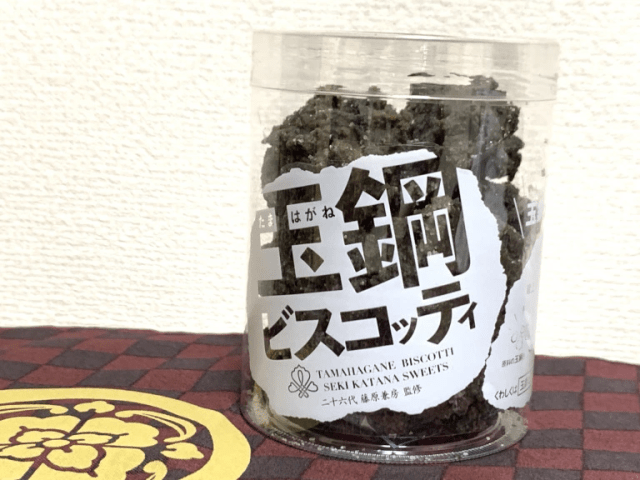
26th-generation swordsmith oversees the creation of Tamahagane Biscotti.
There are several unique aspects of Japanese swordsmithing, and that goes right down to the material used. Katana are traditionally forged with what’s called tamahagane, which literally means “ball steel.”
Tamahagane contains a high concentration of iron sand and forms in irregular clumps. In unrefined form, it has a dark, dull color, but there are also specks of shine if you look closely enough.
▼ Tamahagane
We recently saw a tamahagane sample on display in the town of Seki, Gifu Prefecture. Seki has been Japan’s premier sword-producing city since the samurai era, but this particular piece of tamahagane wasn’t on display in a museum or cutlery shop, but inside snack shop Seki Milk, which also sells tamahagane-themed cookies!
Officially, they’re called Tamahagane Biscotti, which adds a bit of multilingual appeal to their sweet and historical charms. The “samurai steel cookies” are produced under supervision from 26th-generation Japanese swordsmith Kanefusa Fujiwara, who also was involved with the creation of the tasty Katana Ice frozen treat we ate at Seki Milk, and so we decided to pick up a container of Tamahagane Biscotti for 850 yen (US$7.90).
Katana aren’t produced via an automated process, and so neither are the Tamahagane Biscotti. Each cookie is handmade to ensure an irregular shape, and visually they look amazingly similar to actual tamahagane steel, right down to flecks of light color (which in the biscotti’s case come from salt and almond powder).
▼ Steel (left) vs. cookie (right)
As a matter of fact, the sweets look so much like their edged weapon-related inspiration that we were almost afraid we were going to chip a tooth as we took our first bite. To our relief, though, Tamahagane Biscotti contain no actual metal, and are crispy but light, breaking apart easily without any warrior-level use of strength in your jaw muscles.
They taste great too, with the star ingredient being rice flour made with hatsushimo rice. Hatsushimo is a rare strain grown locally in Seki, and is known as a type of rice that retains its delicious flavor even at room temperature. As for the color, it comes from the use of edible bamboo charcoal, the same ingredient in the black hamburgers which were all the rage in Japan a while back.
Like hatsushimo rice, the Tamahagane Biscotti aren’t easy to come by. In Seki, they’re only sold in three places: Seki Milk, confecionary shop Seki Toraya, and the Seki Hamono Museum. In Tokyo, the only place you can purchase them is the Japanese Sword Museum in Sumida Ward, but to be honest, if you’re the kind of person who’s intrigued by samurai steel cookies, odds are you won’t mind heading to a samurai sword museum to get some.
Shop information
Seki Milk / 関牛乳 株式会社
Address: Gifu-ken, Seki-shi, Kannonmae 41
岐阜県関市観音前41番地
Open 9 a.m.-6 p.m. (weekdays), 9 a.m.-5 p.m. (weekends, holidays)
Related: Tamahagane Biscotti website
Photos ©SoraNews24
● Want to hear about SoraNews24’s latest articles as soon as they’re published? Follow us on Facebook and Twitter!
[ Read in Japanese ]

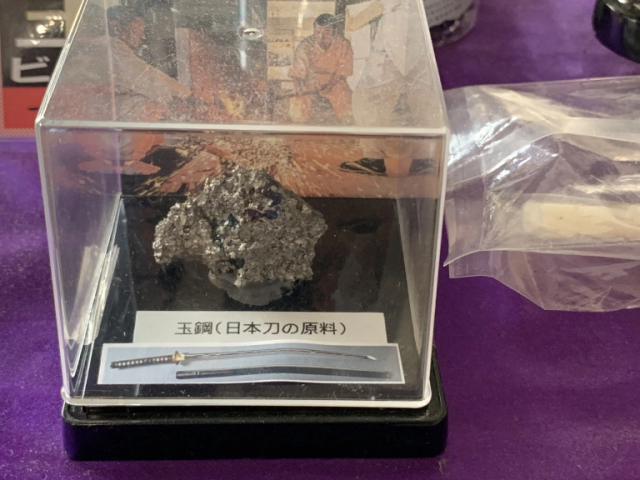
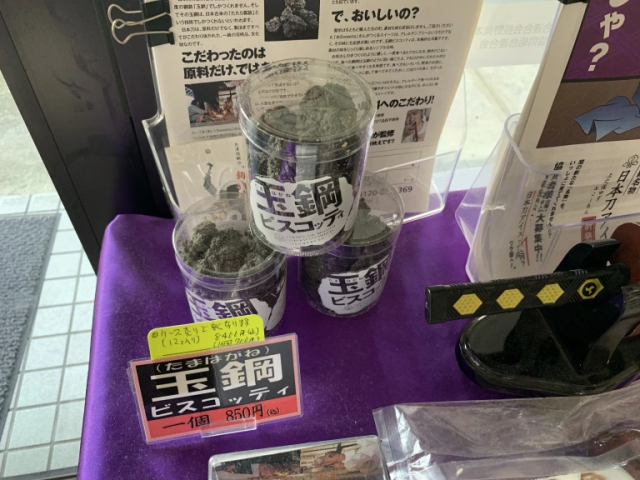
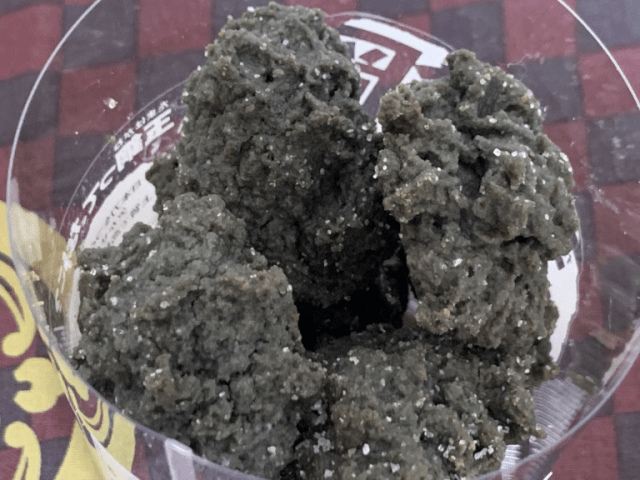
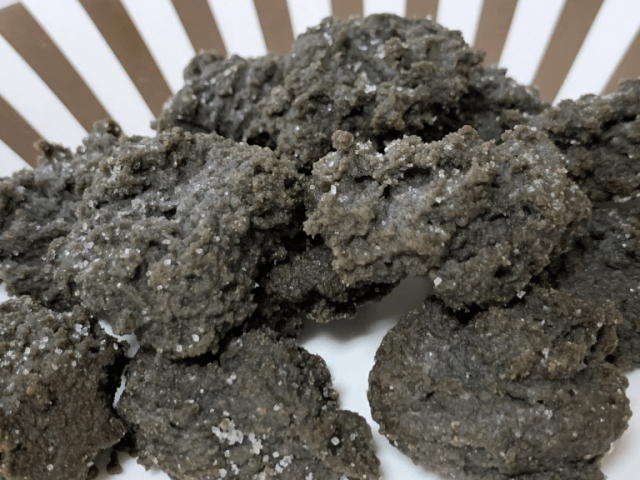
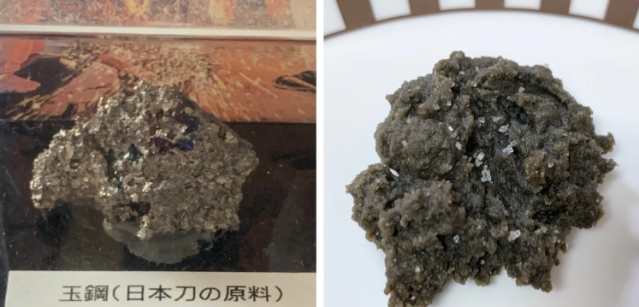
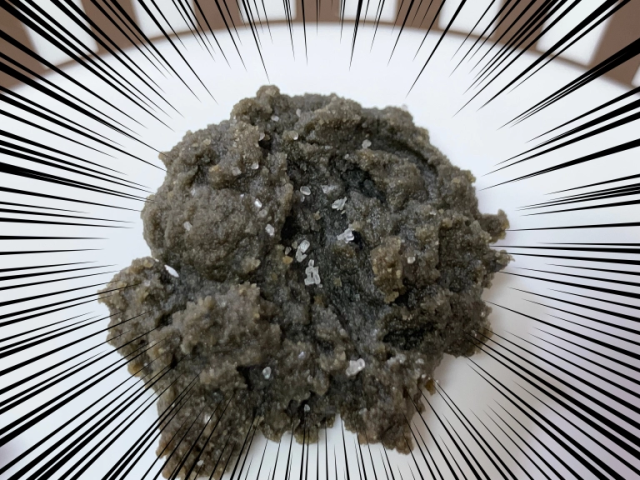
 Japanese samurai sword ice cream crafted by master swordsmith from famous katana town of Seki
Japanese samurai sword ice cream crafted by master swordsmith from famous katana town of Seki Real-life Rurouni Kenshin katana forged based on sword of series’ most merciless villain【Photos】
Real-life Rurouni Kenshin katana forged based on sword of series’ most merciless villain【Photos】 One Piece anime katanas recreated as exquisite letter openers by Japan’s swordsmith legacy heirs
One Piece anime katanas recreated as exquisite letter openers by Japan’s swordsmith legacy heirs Japanese city famous for its production of swords and knives now has katana-shaped ice cream
Japanese city famous for its production of swords and knives now has katana-shaped ice cream Jewelry forged with Japanese sword-making techniques are a cut above the rest
Jewelry forged with Japanese sword-making techniques are a cut above the rest Demon Slayer: Kimetsu no Yaiba gets new roller coaster attractions and food at Universal Studios Japan
Demon Slayer: Kimetsu no Yaiba gets new roller coaster attractions and food at Universal Studios Japan Japan’s new difficult-to-drink-from beer glass protects your liver, but it’s a brutal experience
Japan’s new difficult-to-drink-from beer glass protects your liver, but it’s a brutal experience New Nintendo Lego kit is a beautiful piece of moving pixel art of Mario and Yoshi【Photos】
New Nintendo Lego kit is a beautiful piece of moving pixel art of Mario and Yoshi【Photos】 How to order snacks on a Shinkansen bullet train in Japan
How to order snacks on a Shinkansen bullet train in Japan New samurai glasses are Japan’s latest weird must-have souvenir
New samurai glasses are Japan’s latest weird must-have souvenir Come play hide-and-seek on a deserted Japanese island this August and November
Come play hide-and-seek on a deserted Japanese island this August and November New Pokémon ice cream, dessert drinks, and cool merch coming to Baskin-Robbins Japan【Pics】
New Pokémon ice cream, dessert drinks, and cool merch coming to Baskin-Robbins Japan【Pics】 Caffeinated ramen for gamers that you can eat with one hand going on sale in Japan
Caffeinated ramen for gamers that you can eat with one hand going on sale in Japan Starbucks Japan unveils New Year’s collection for 2024, with daruma, dragons and Mt Fuji for luck
Starbucks Japan unveils New Year’s collection for 2024, with daruma, dragons and Mt Fuji for luck Real Buddhist monk plays Super Mario Bros., recites prayers every time he kills an enemy【Video】
Real Buddhist monk plays Super Mario Bros., recites prayers every time he kills an enemy【Video】 Nintendo history you can feel – Super NES, N64, and GameCube controllers become capsule toys
Nintendo history you can feel – Super NES, N64, and GameCube controllers become capsule toys Hello, cosmetics! Clinique teams up with Hello Kitty this summer for first-time collaboration
Hello, cosmetics! Clinique teams up with Hello Kitty this summer for first-time collaboration “The most Delicious Cup Noodle in history” – Japan’s French Cup Noodle wins our heart【Taste test】
“The most Delicious Cup Noodle in history” – Japan’s French Cup Noodle wins our heart【Taste test】 Starbucks releases a cute Frappuccino and Unicorn Cake…but not in Japan
Starbucks releases a cute Frappuccino and Unicorn Cake…but not in Japan Kyoto Tower mascot termination reveals dark side behind cute Japanese characters
Kyoto Tower mascot termination reveals dark side behind cute Japanese characters McDonald’s Japan’s Soft Twist Tower: A phantom ice cream only sold at select branches
McDonald’s Japan’s Soft Twist Tower: A phantom ice cream only sold at select branches Yabai Ramen: What makes this Japanese ramen so dangerous?
Yabai Ramen: What makes this Japanese ramen so dangerous? Finally! Nintendo Japan expands Switch 8-bit controller sales to everybody, Online member or not
Finally! Nintendo Japan expands Switch 8-bit controller sales to everybody, Online member or not Japanese government wants to build luxury resorts in all national parks for foreign tourists
Japanese government wants to build luxury resorts in all national parks for foreign tourists To combat declining birth rate, Japan to begin offering “Breeding Visas” to foreigners
To combat declining birth rate, Japan to begin offering “Breeding Visas” to foreigners 10 things you should buy at 7-Eleven in Japan
10 things you should buy at 7-Eleven in Japan Studio Ghibli releases anime heroine cosplay dresses that are super comfy to wear
Studio Ghibli releases anime heroine cosplay dresses that are super comfy to wear Woman charged for driving suitcase without a license in Osaka
Woman charged for driving suitcase without a license in Osaka Studio Ghibli unveils My Neighbour Totoro miniature house model
Studio Ghibli unveils My Neighbour Totoro miniature house model Kyoto experiencing problems with foreign tourists not paying for bus fares, but not on purpose
Kyoto experiencing problems with foreign tourists not paying for bus fares, but not on purpose Fighting mild hunger with a Japanese soda that turns into jelly in the stomach【Taste test】
Fighting mild hunger with a Japanese soda that turns into jelly in the stomach【Taste test】 Studio Ghibli’s Howl’s Moving Castle tapestry unveiled in Japan for first time
Studio Ghibli’s Howl’s Moving Castle tapestry unveiled in Japan for first time McDonald’s new Happy Meals offer up cute and practical Sanrio lifestyle goods
McDonald’s new Happy Meals offer up cute and practical Sanrio lifestyle goods Sales of Japan’s most convenient train ticket/shopping payment cards suspended indefinitely
Sales of Japan’s most convenient train ticket/shopping payment cards suspended indefinitely Sold-out Studio Ghibli desktop humidifiers are back so Totoro can help you through the dry season
Sold-out Studio Ghibli desktop humidifiers are back so Totoro can help you through the dry season Japanese government to make first change to romanization spelling rules since the 1950s
Japanese government to make first change to romanization spelling rules since the 1950s Foreigner’s request for help in Tokyo makes us sad for the state of society
Foreigner’s request for help in Tokyo makes us sad for the state of society Ghibli founders Toshio Suzuki and Hayao Miyazaki contribute to Japanese whisky Totoro label design
Ghibli founders Toshio Suzuki and Hayao Miyazaki contribute to Japanese whisky Totoro label design Doraemon found buried at sea as scene from 1993 anime becomes real life【Photos】
Doraemon found buried at sea as scene from 1993 anime becomes real life【Photos】 Tokyo’s most famous Starbucks is closed
Tokyo’s most famous Starbucks is closed Princesses, fruits, and blacksmiths: Study reveals the 30 most unusual family names in Japan
Princesses, fruits, and blacksmiths: Study reveals the 30 most unusual family names in Japan 700-year-old swordcrafting ceremony lives on in Gifu Prefecture【Video】
700-year-old swordcrafting ceremony lives on in Gifu Prefecture【Video】 Japanese city offering authentic handcrafted swords in exchange for “tax” payments
Japanese city offering authentic handcrafted swords in exchange for “tax” payments Samurai sword hunt begins as storm washes away blacksmith’s warehouse in Gifu Prefecture
Samurai sword hunt begins as storm washes away blacksmith’s warehouse in Gifu Prefecture Real-life Rurouni Kenshin reverse-blade katana, forged by master swordsmith, now on display【Pics】
Real-life Rurouni Kenshin reverse-blade katana, forged by master swordsmith, now on display【Pics】 Shaved ice? No thanks – we’re having a shaved milkshake at this Japanese cafe instead!【Photos】
Shaved ice? No thanks – we’re having a shaved milkshake at this Japanese cafe instead!【Photos】 Mini samurai sword scissors are here to help you slice paper and plastic foes to pieces【Photos】
Mini samurai sword scissors are here to help you slice paper and plastic foes to pieces【Photos】 Driving just became so much more thrilling with this katana-handle shift knob
Driving just became so much more thrilling with this katana-handle shift knob Samurai armor and mini katana tableware is here to keep your bottles safe and your food stabbed
Samurai armor and mini katana tableware is here to keep your bottles safe and your food stabbed Smashing cakes and eating hair: City in Gifu Prefecture releases bizarre PR video【Video】
Smashing cakes and eating hair: City in Gifu Prefecture releases bizarre PR video【Video】 Swords of famous samurai reborn as beautiful kitchen knives from Japan’s number-one katana town
Swords of famous samurai reborn as beautiful kitchen knives from Japan’s number-one katana town Legendary crescent moon katana, one of Japan’s Five Swords Under Heaven, now on display in Tokyo
Legendary crescent moon katana, one of Japan’s Five Swords Under Heaven, now on display in Tokyo Japan is running out of swordsmiths, and a strict apprenticeship requirement is a big reason why
Japan is running out of swordsmiths, and a strict apprenticeship requirement is a big reason why Katana of four of Japan’s greatest samurai turned into gorgeous scissors
Katana of four of Japan’s greatest samurai turned into gorgeous scissors Is it a Lawson or a train station? We investigate the mysterious Sekiguchi Station
Is it a Lawson or a train station? We investigate the mysterious Sekiguchi Station Japan’s legendary Brother Katana might not be brothers after all? Investigating the mystery【Pics】
Japan’s legendary Brother Katana might not be brothers after all? Investigating the mystery【Pics】
Leave a Reply